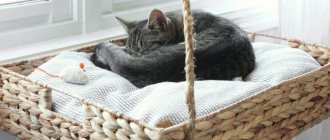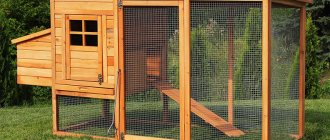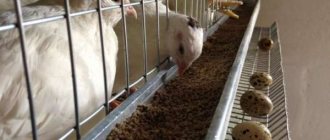When engaged in the construction and interior decoration of a chicken coop, it is necessary to pay close attention to the preparation of nests intended for laying eggs, since their proper location and arrangement stimulates the egg production of chickens and improves the quality of eggs, protecting them from damage, pecking and contamination by bird droppings.
The presence of well-equipped nests is a benefit not only for laying hens, but also for their owner, since they relieve him of the need to look for eggs in corners or in hard-to-reach places of the chicken coop, and also prevent the possibility of other birds pecking at the eggs.
Nowadays, ready-made nests and wooden houses for poultry can be purchased in stores for farmers and poultry farmers, but home-made nests for laying hens will save a considerable amount from the family budget.
Types of nests for laying hens
Nests for chickens may vary:
- by design - open or closed, with or without egg collectors;
- by the number of rows - single and multi-tiered;
- by material - wooden (plywood, timber, chipboard, OSB), metal, plastic, cardboard, wicker, twigs and even old tires;
- according to the method of fastening - on supports and mounted;
- according to the manufacturing method - purchased factory-produced models or hand-made ones.
This is how we will talk about how to make a nest for a laying hen yourself.
Double bottom nest
The following design of a chicken nest is designed to protect products from pecking. Its peculiarity is the presence of a false bottom with a slope and a hole into which the laid egg will roll, hiding from the bird’s field of view. The difference from a simple booth is the enlarged sidewalls and inclined floor parts installed inside.
To create such a nest, you need to do the following:
- when cutting, increase the length (height) of the sides and back by 15-20 cm;
- supplement the design with 2 false bottom parts: their width is calculated so that when installed inside the box there is a gap of about 7 cm between them;
- you will need to cut supports from the block to install the raised floor parts in an inclined position;
- make it yourself or choose a suitable tray for the eggs to roll into;
- provide soft bedding in the tray.
The assembly of the main box is carried out according to the booth diagram. Before assembly, a support block for an inclined floor is secured to the inside of each side wall. After the outer walls are installed, 4 false floor parts need to be inserted and secured inside the box. A box filled with soft material is placed in the pallet. The egg will roll between the inclined boards and fall into the tray, from which it can be removed.
Basic requirements for nests
When making nests for chickens, we take into account their population, the characteristics of the breed and its varieties, since crosses, for example, are usually larger.
The recommended dimensions of one nest for laying hens are shown in the table.
| Variety | Width, mm | Depth, mm | Height, mm |
| Egg | 260 – 300 | 360 – 400 | 320 – 360 |
| Meat-egg | 310 – 350 | 410 – 450 | 440 – 500 |
The number of nests is taken at the rate of 1 nest for 3-4 laying hens. Perches need to be attached in front so that the chicken can easily enter and exit the nest.
When making multi-tiered structures, a ladder leading to these perches should be provided.
The roof is made sloping so that chickens do not sit on it. The nest must be dry, so it is advisable to make the bottom mesh for ventilation. It should not have chips, sharp protrusions, protruding fastening elements, etc.
Take this into account when manufacturing (cleaning surfaces) or when choosing available tools.
For example, if baskets are used, you need to make sure that there are no broken ends of vines sticking out inside them.
And if the products are plastic, that they have no cracks or sharp edges that could injure the hen. They are not durable and should be regularly inspected for such damage.
The perches in front need to be strengthened so that the chicken can easily enter and exit the nest.
Dimensions
When building nests, it is necessary to take into account the breed of chickens:
- For ordinary laying hens, small structures with the following parameters will be sufficient: 25x35x35 cm.
- Individuals of meat and egg breeds need more spacious shelters with dimensions of 30x40x45.
Each nest (regardless of the breed) must have a threshold with a height of 5 to 8 cm, as well as a special bar designed for birds to take off (located ten centimeters from the entrance and having a cross-section of 5x2 cm).
With a large number of laying hens, it is advisable to place nests in 2-3 tiers, making sure that the height of the nests of the lower tier is at least 30-40 cm from the floor level.
Above the upper tier it is necessary to make a reliable roof with an angle of inclination equal to 45-50 degrees (such a slope is needed in order to wean chickens from the habit of sitting on the roof and soiling nests with their droppings).
Types of designs
Both perches and nests for chickens can be made independently.
- In the form of a booth - the chickens come inside through the entrance opening, they are calm and safe, the bustle of the poultry house does not distract or irritate them. To accustom them to such a nest, they are placed there and closed in the morning.
- In the form of a box. This is the simplest design, there is no roof, an open entrance that has a small side.
- From baskets, buckets, boxes, lined with straw, available on the farm. They are used in small farms or at the initial stage of farming, when the chicken coop is not yet fully equipped.
- With sloping floor and egg collector. This complicates the design, but makes it easier to collect eggs and prevents them from being spoiled by laying hens.
Nest with egg collector
Sometimes the bird begins to peck at its own products, destroying some of it and staining other eggs. In this case, it is advisable to install nests for chickens with an egg collector, where the egg is rolled immediately after laying, hiding from the sight of those who like to feast on it.
The design is based on the principle of making a nest-box. The difference between the new model is the enlarged floor detail and the shortened heel. These parts should be cut like this:
- the backdrop is shortened in height so that there is a gap of about 10 cm between its lower edge and the floor;
- the bottom part is increased in length (depth measure): it should protrude beyond the back wall by at least 15 cm and have a slope, which will also require an increase in length by at least 5 cm.
Assembly is carried out using the same technology, securing the bottom with a slope from the front to the back. A block attached along the edge will prevent the egg from rolling off the sloping bottom. To slightly reduce the speed of rolling, attach a flap made of thick fabric, plastic, or rubber to the gap under the backdrop.
The valve should open easily, allowing the egg to pass out of the nest. In a tray formed by slats, it is advisable to place a soft bedding that will slow down the rolling object and prevent it from breaking on the sides. If the tray is inconvenient to install on the back wall, the floor can be made sloping towards the side wall and the slope can be moved beyond it.
What material is suitable for creating nests?
The main requirement for materials is strength and safety. Many poultry houses, when purchasing or making homemade structures, designs pay attention to their environmental friendliness.
Most often this is wood and particle boards. Galvanized iron is also used; when using improvised means, products made of rods and plastic are used.
Factory products are often made of plastic.
Nest made from scrap materials
Sometimes poultry farmers make nests from old, used ones:
- plastic and metal buckets;
- pots;
- canisters;
- wide pipes.
All this is suitable for making a nest. However, you should carefully ensure that the materials are environmentally friendly and do not contain toxic products. There is no point in spending very expensive materials on nests. As a result, it may turn out that you need to collect eggs for a year and sell them to pay for the nests.
Nests made from plastic buckets
Nests made from plastic boxes
Nests are places where food is collected. They must be clean. The litter should be changed at least once every 5-6 days.
The chicken will quickly take a liking to properly made and installed nests. If a bird refuses to lay eggs in the nest, there is no point in forcing it, it’s better to think, feel what’s wrong and change it. The bird will reward you with good egg production.
Like the author!3
- Even more interesting:
- How to organize proper feeding of turkey poults
- How and what to feed laying hens to lay eggs better
- Properly caring for goslings
Mounting in the chicken coop
To avoid injury to the hens, home-made nests must be securely installed.
- On racks that can be placed anywhere in the chicken coop.
- On console shelves.
- Directly to the walls, if hanging structures are provided, which requires additional insulation.
Consider making your own cantilever shelves. Their length must correspond to the total length of the installed sections.
We make the width of the shelves 200-250 mm larger than the depth of the nests, to create a gap between the outer wall and the nest on one side and a platform in front of the entrance about 120 mm wide, then a perch for the bird to take off is not needed.
The manufacture of the cantilever shelf is described below.
- We attach a support beam to the outer wall; its length should be equal to the length of the shelf.
- On top of the support beam we attach transverse ones, the length of which corresponds to the width of the shelf, the distance between them is about 1 m.
- Under each cross beam we mount a jib to the wall, sawing its ends at 45°.
- We connect the ends of all cross beams with a board 80-120 mm wide.
- We construct the flooring; it can be made of boards or slats, either solid or lattice.
- This design can be made multi-row if necessary.
Installing a homemade nest
Homemade nests are most often attached to the wall of the chicken coop as follows:
- First, a base stand made of a strong board and measuring 30 × 4 × 2 cm is attached to it using screws.
- Another (exactly the same) part is attached at an angle of 45 degrees. The angle formed by both parts should diverge at the bottom of the fastening. The distance between the edges of the planks should be at least 40 cm.
- Having measured 45 cm, perform a similar fastening, the slats of which should meet at the top.
- A homemade socket is inserted into the compartment formed by four attached bars and attached to the obliquely located slats using screws.
Nest care
Caring for nests for laying hens is much easier if they are made with an egg collector. They are much cleaner, there are no remnants of accidentally crushed or pecked eggs. This means that there is no need to regularly clean the bottom grate from dried protein-yolk residues and shells.
This place should be a comfortable place, which means cozy, clean, dry. Caring for it consists of daily replacement of the bedding and cleaning of the tray.
Disinfection and ventilation of the bottom should be done at least once a week. At the same time, you need to clean and ventilate all surfaces and fastenings.
To combat parasites, it is recommended to periodically fumigate the entire room with special bombs for caring for the poultry house.
Parts of the structure and its fastenings should be inspected for damage, strength and rigidity.
On the eve of the onset of cold weather, it is necessary to check and, if necessary, replace all insulation, and in the future strictly control the temperature of the laying hens; it should not fall lower than +15°C.
Making nests for laying hens
Designs come in different levels of complexity. The simplest ones do not need design, but capital solutions cannot be built without accurate drawings (you can learn about programs for creating drawings and diagrams from the article on our website).
Nests for laying hens: drawings with dimensions
Let's consider several options for nests.
The first picture shows a double-sided nest that can be placed in the center of the coop.
Drawing of a nest for laying hens with an egg collector
These solutions are used in poultry farms. They have automatic doors driven by an electric drive. At a time when chickens are not laying eggs, they will not be able to bring debris and dirt inside.
The floor of the nest has an inclined shape. The eggs roll down it and end up on a conveyor. Of course, such mechanisms are useless for a home chicken coop, but by somewhat simplifying the design, you can get comfortable nests. Instead of a conveyor, you can adapt a retractable tray that will go into the next room. This will allow you not to disturb the chickens with your presence.
This drawing shows a compact nest with an egg collector.
Classic nest design with egg receptacle
They can also be stacked on top of each other. The nest was made according to the following principle.
- The basis is a small wooden box, on one side of which there is an entrance in the upper part.
- There is a double bottom inside. Its upper part is inclined towards a smaller passage, covered with a light curtain, which will bend under the weight of the egg rolling from above
- Under this shelf there is bedding - the same sawdust. This allows the nest to be well insulated.
- An egg receptacle is attached to the lower passage, at the bottom of which sawdust is also poured, which will soften the blow.
- It may seem that the chicken would be uncomfortable sitting on an inclined surface, but this is not the case. The tilt of the moving board should be 15-20 degrees. This is enough for the bird's comfort and for the eggs to roll down.
The following picture shows the type of nest where the egg receptacle is located under the hen.
Design of a nest for laying hens with a pull-out tray
From the outside, the structure of such a nest is no different from other models. We see a closed box, the entrance to which is covered with a folding door that the chicken can overcome on its own. Again, this measure is needed to reduce litter in the nest.
Inside we see a gable double bottom, in the middle of which there is a hole sufficient for the passage of eggs.
Below is a retractable tray, which also has a sloping bottom. That is, the egg travels this way - it rolls to the center of the nest, falls into the tray, and rolls down to its edge. The distances must be strictly adjusted so that the fall of the egg does not cause damage to the shell. Places where an impact may occur should be covered with a soft material, for example, a thin layer of rubber, which will soften the impact.
In principle, the structure of other options will not differ much. Some models may have small functional additions. For example, the following picture shows that the egg tray is accessed not by pulling it out, but by lifting the entrance platform.
Lifting mechanism
You can immediately see that the bottom of the tray is lined with soft synthetic material.
Read on our website: typical poultry house designs.
How to build a nest
The simplest version of a nest for laying hens can be made from an old plastic food box. Their peculiarity is that they are securely placed on top of each other, which will allow you to build a compact multi-place battery. The products are strong enough that they can even be screwed to the wall of the chicken coop, as shown in the photo below.
Hanging nests from plastic boxes
The disadvantage of this solution is that one such box takes up quite a lot of space, and the bird may not be entirely comfortable due to the internal space.
Boxes should not be placed on the floor, as this will not have the best effect on the health of the bird, so even under the plastic it is necessary to build a small wooden platform.
To work you will need the following set of materials:
- Plywood for walls and shelves. It can be replaced with boards, but then you will have to tinker with the assembly longer.
- Beam 35*35 mm or larger for building a nest frame.
- Metal fasteners. It is best to assemble the products using self-tapping screws, so that there is still the possibility of quick disassembly, which may be required to redesign the structure.
- Sandpaper for surface treatment – we have already written about the quality of the product.
This structure is completely assembled from plywood.
The tools you will need are a standard carpenter's set: a hammer, a screwdriver, an electric jigsaw and a tape measure with a pencil.
The work proceeds in the following order:
- A drawing is being developed that takes into account the size of the chicken coop and the number of cells required.
- Next, the bars for the frame are cut according to the calculated dimensions. It is recommended to pre-treat the wood with sandpaper before it is dissolved into small parts. If you have a sanding machine, the work will be greatly simplified.
- According to the developed drawing, we cut the parts and knock together a frame, which we can then begin to cover with sheets of plywood to increase the strength of the structure.
- If your product is multi-tiered, you should build platforms for climbing to the top. They are made from inclined boards, on which jumpers in the form of steps are filled with small steps.
- We make sure to make take-off pads.
Assembling a chicken nest from boards and an old pallet
Tip! If you don’t want to bother with the assembly at all, and options like an old bucket as a nest don’t suit the owner, then you can buy special plastic products in stores. They come in wall-mounted and floor-mounted types. They can be mounted on the wall of the chicken coop or on a specially equipped stand.
Ready-made nest for laying hens
By and large, the procedure for assembling a nest with an egg collector will not be any different. The structure is also made frame, only a pallet is added at the bottom.
When assembling such nests, care should be taken to ensure that chickens do not have access to the laid eggs. The collection section can even be fenced with a chain-link mesh, as shown in the following photo.
The eggs from such a nest will always be clean
If you want the nest to be comfortable for the bird at any time of the year, you should take care of its insulation. In this case, the frame is covered with plywood on both sides so that the birds do not come into contact with the insulation. In order for the nest to be properly ventilated, it is worth using mineral wool, or supplementing its design with vents.
Experienced poultry farmers know that when laying eggs, a chicken’s body temperature rises to almost 40 degrees. If the nest is cold, she will have to expend more energy to maintain the specified body temperature, which will ultimately negatively affect the bird's overall performance.
There's definitely not enough room for four here.
You can learn more about building a chicken coop at your dacha from the article on our website.
How to train a laying hen to the nest
A young laying hen, if she does not see the example of more experienced hens, will have to be taught to lay eggs in the right place. Layers with experience also have to be accustomed to a new place.
Training methods:
- Remove old places for laying eggs or, if they are still needed, temporarily block chickens’ access to them.
- Place dummies or real eggs, chicken fluff, and feathers in the new ones.
- Close the chickens in the nest, if its design allows.
If you encounter any difficulties, you need to follow the steps described below.
- Make sure that the location for the masonry was chosen correctly (darkness, temperature, distance).
- Check for cleanliness, presence of bedding, absence of chips, sharp protrusions, dampness, mold, and parasites. Parasites are usually invisible to the eye.
- It is advisable to place bowls of ash in the chicken coop for the laying hens to bathe in order to protect them from feather eaters and other troubles.
Rules for placement and fastening
The second stage of arranging nests for laying hens is the correct installation and placement of them in the chicken coop. They need to be placed long before the birds start laying eggs, in the most secluded, darkest place in the poultry house; the chickens should be comfortable in the nest. They should feel calm in it. It is not recommended to place them in an open place, for example, close to the door, or where there are drafts - sitting in the nest, the bird can catch a cold.
You can attach the nests to the wall, but not close to it, but at some distance from it. In this case, they are hung on wide slats located horizontally or vertically. It turns out that there is a small gap between the sockets and the wall.
You can also put the nests on legs, placing them not close to the wall, but at some distance from it. It is important to install them so that it is easy not only for the chickens, but also for you to collect products and care for the devices. The height of the nest from the floor should be at least 0.3 m, up to 0.8 m is permissible. The space under them can be used to place containers with ash, in which the chickens can bathe.
What is better, ready-made or homemade?
Making comfortable nests for laying hens with your own hands is quite simple and not difficult, especially since they are built taking into account the breed, number of chickens and dimensions of the chicken coop.
Manufacturing will require additional effort and time from the poultry farmer, but they will be much cheaper than store-bought ones, and if they are made from improvised materials, then absolutely free.
If the owner of the chickens does not know how to craft or does not want to spend his time making a nest, he can purchase ready-made, industrially produced ones.
You can order online in an online store, or contact specialized stores or specialized agricultural workshops.
With pallet
Many farmers use standard perches with plastic trays. In fact, this structure is somewhat similar to the construction of simple poles, but at the bottom of the structure there is the same pallet.
It is worth noting that the litter does not need to be thrown away. It is used as fertilizer in the garden and is even sold.
To make such a perch, you need to perform a number of actions:
- First of all, at a distance of ninety centimeters from the floor, bars are placed that will serve as supports.
- Then, using a plane and sandpaper, you should process the wood so that the chickens are not injured.
- Next, step back thirty centimeters from the wall and nail several beams to the base.
- We attach small blocks on the sides, the height of which is forty centimeters, then attach the pallet.
- Any metal or plastic container can be used as a pallet. Wood should not be used; it absorbs all substances well and is difficult to clean.
- Finally, using wood, a ladder is made and leaned against the main perch.
Prices for nests
A simple plastic purchased one-section nest will cost a poultry farmer around 1000 - 1700 rubles.
Prices for metal and plastic products with egg collectors start from 3500 - 5500 rubles for a two-section design and 6500 - 9500 rubles for 4 sections, up to more than 20 thousand for multi-section products.
Nests made of wood and particle boards can also be bought from the manufacturer; they will cost about half the price; for example, a ready-made four-section nest with an egg collector can be bought for 2,200 rubles.
The cost of such a DIY craft will be several times lower, not to mention those made from scrap materials.
Making a box-shaped structure
To create such a cage for chickens you need:
- boards;
- plywood;
- beam;
- sandpaper;
- screwdriver;
- hammer;
- fasteners;
- jigsaw
The nests are located next to each other in several tiers.
The boards need to be sanded with sandpaper to remove any protruding wood chips that could injure the chickens. Then you need to cut out the blanks. Calculations must be accurate so that the container is not too small for the birds. Nail the boards together. Secure timber from the inside to increase the strength of the structure. Leave the exit open. In the front bar, you can make round holes according to the number of layers.
For the threshold, take a board 10 cm wide. It must be secured from the entrance along the entire length of the box. Make a platform for take-off 10 cm from the entrance.
If the structure has several tiers, stairs should be installed, one or more for each. Horizontal surfaces must be coated with stizol to prevent the material from deteriorating due to bird droppings.
Useful tips
When making and installing nests for chickens, we advise you to listen to the recommendations of experienced poultry farmers.
- They cannot be installed directly on the floor. The distance to it should not be less than 40 cm. This space can be used to install ash baths.
- The flooring in nests without an egg collector is poured 40-50mm below the sides of the structure.
- To prevent laying hens from sitting on the covers and soiling them, the roofs should be made at an angle of 45°.
- To prevent chickens from spending the night in nests, soiling the bedding, it is better to close the entrance to them in the evening; they are opened in the morning, since chickens lay eggs in the morning.
- To save space, nests can be made in multiple rows, and ladders should be provided along which the hen will climb to them.
- Before introducing chickens into a chicken coop, the nests must already be installed, otherwise the chickens may get used to laying eggs in another place, and they will have to be retrained.
- It is better not to use light fillers such as hay or straw as bedding, since laying hens easily scatter them. Wood chips are preferable because they are heavier and, in the case of a design with an egg collector, rolling over their surface is easier.
What do you need to know?
The most important factor to consider when building nest boxes is their internal dimensions. When keeping egg breeds of birds, the following dimensions of the nest for chickens are observed:
- width - 25 cm;
- height - 35 cm;
- depth - 35 cm.
Households often keep meat and egg poultry, which is larger in size. For these chickens, the width, height and depth are 30, 45 and 40 cm, respectively.
To prevent nest litter from being scattered, a side is installed on the front of the nest box. The height of the threshold must be at least 5 cm. In front of the entrance, it is recommended to make a shelf onto which a bird about to lay eggs will fly. The shelf should be wide enough for a chicken to walk along it. Sometimes this detail is made in the form of a perch. Then it is placed parallel to the front wall at a distance of 10-15 cm from it. The section of the bar is 5x2 cm.
It is advisable to make the roof of the nest boxes steeply inclined (at least 45°). This will prevent chickens from trying to sit on it.
Perch with crossbar
Instead of a vertical perch in the shape of a ladder, but without giving up the presence of a perch, you can build a perch with a crossbar at the top.
You will need:
- block size 50*50 or 40*60;
- sheet of plywood, hardboard, iron and any other sheet panels;
- wooden boards;
- mesh (large and durable).
Build process:
- 4 boards are fastened together to form an even rectangle (the dimensions of the boards should be selected in advance so that they do not have to be adjusted during the assembly process), and the lower base is closed and stitched with sheet material selected in advance;
- bars are fixed along the inner perimeter, onto which a net will later be attached to collect chicken droppings. Then you should begin installing the racks on the sides, on which the perch itself will be fixed;
- The design will be removable, which is very convenient to use - you can quickly and easily wash and clean it inside. We must not forget to grind down the edges of the crossbar so that the chickens are comfortable and do not accidentally injure their paws;
- A small amount of sawdust is poured inside the tray-box, and a protective grill is installed on top. garbage, feathers and droppings should be removed once a week, then the roost can be called “hygienic”.
In the summer, when chickens walk a lot, cleaning can be done much less frequently, because the birds will only come to roost to spend the night.
Breed selection
For home breeding, breeders often choose representatives of the following types of breeds:
- Meat. They are distinguished by their large size and average egg production. Females of meat breeds are recognized as good brood hens.
- Egg. They have a small weight - on average up to 2.5 kg, but are characterized by increased egg production. Among the disadvantages, it can be noted that chickens of egg breeds are often exposed to various diseases.
- Meat and eggs. Not as prolific as representatives of egg breeds, but they weigh more and are also excellent brood hens. They do not require special conditions and are excellent for breeding at home, as they have a calm disposition and are rarely susceptible to disease.
To raise chickens at home or in the country, you must first purchase chickens. To do this, you should immediately contact reliable suppliers who sell individuals of productive breeds. The most popular of them can be found below:
| Breed | Egg production (pieces per year) | Weight (kg) | Description |
| Loman Brown | 315 | 2-3 | Hardy chickens that have brown plumage. They lay eggs weighing up to 64 g. They show high productivity for 80 weeks, so keeping them further is unprofitable. |
| White Leghorn | up to 330 | 2-3 kg | The most highly productive breed for home keeping, which is of Mediterranean origin. Egg production decreases after a year of keeping. Females lay eggs weighing up to 60 and with a white shell. |
| Hisex Brown | 315 | 2,3-2,7 | The survival rate of chickens is high - 99%. When kept free-range, they begin to lay eggs at 4 months. Chickens lay large eggs - weighing 70 g. |
Rhode Island
230
Until 3
Chickens of this breed are characterized by increased mobility. They adapt well to free range. They have brown or dark golden plumage. With their participation, you can breed broilers by crossing a hen with a rooster of the Kuchinsky Jubilee breed. Amrox
200-220
3,5-4,5
A meat and egg breed of chickens bred in Germany. Its representatives look quite massive due to their loose plumage, which does not fit tightly to the body. Egg production decreases slightly after the first year. The eggs have a strong light brown shell and weigh on average 56-60 g.
Adler silver
180
3-4
A peaceful and calm bird with beautiful, but poorly developed plumage. Begins laying eggs at 6 months. The egg production period lasts up to 4 years, and during this period the number of eggs does not fall.
Moscow black
170-180
2,5-3,3
The plumage of these chickens is very beautiful - black with golden feathers on the neck. From 5 months of age they begin to lay large eggs, which can weigh up to 62 g.
Russian white
250
1,5-2,4
A hardy and frost-resistant bird that has a calm temperament and grows quickly. Ripens early - by 5 months. Lays white eggs weighing an average of 56-60 g.
New Hampshire
220
2-3,5
A friendly bird with red-brown plumage. Not afraid of frost. Lays yellow-brown eggs weighing 60 g. Productivity decreases by the 3rd year.
Barnevelder
180
2,4-3,5
Dutch breed of domestic chicken. It quickly gains muscle mass, but reaches puberty quite late - at 6-7 months. Lays large eggs weighing 80 g, but small eggs may be found at the beginning of oviposition. Their shade varies from terracotta to dark brown.
Step-by-step manufacturing instructions
- Plywood sheets are processed with a file or emery;
- then you should cut out squares measuring 35 by 35 cm - these are the walls of the house;
- A hole is made in one square into which the chickens will go. A threshold should be made in front of the hole;
- separately prepare bars of the same size as the walls;
- a box is constructed from squares, attaching the walls to the bars with self-tapping screws in the corners. Self-tapping screws should not stick out from the beams, otherwise they will injure the birds;
- you should also check the house for chips and other possible damage;
- then a couple more sheets are cut out of plywood - for the floor and ceiling, which are attached to the main box;
- the bottom is covered with straw (or sawdust;
- The nests are raised above the floor and a ladder is placed.
Solutions
Naturally, one must start from the reason.
If the problem is in the design of the nest itself, you should try to slightly adjust its appearance or create a new one. If we are talking about alterations, it is enough to build something like a roof, then the chickens will not be able to sit on the walls, like on perches, and will sleep on a roost. If you want to give your chicken coop more functionality and neatness, creating new nests is a great idea. There are many models of closed booths, with amenities not only for laying hens, but also for owners, with an openable roof to simplify cleaning and collecting eggs. There are also those that have a slight slope of the bottom along which the eggs roll, which can save them from being eaten by other birds, especially in winter, when they lack nutrients.
It is important that they are not much above ground level, 30 cm is more than enough. It is advisable to make them like a booth, only for chickens, with a roof.
Firstly, this will remove the temptation for pets to sleep in them and, accordingly, to crap. Secondly, in such structures, laying hens will feel much more comfortable and protected. The calculation of the number of nests should be in the ratio of 1 nest per 5 hens.
If there is not enough space for everyone in the chicken coop, you should try to build additional places and in the evening move the chickens from the nests to the correct position. There is a high probability that they will relearn and get used to it. If you notice that the litter is constantly scattered around the chicken coop and almost does not remain in its place, you should change it to another one. It is better to use cut hay, sawdust and other bedding materials as bedding, which are much more difficult for birds to remove from the nest. You can also try mixing several types, such as straw down for softness and a layer of hay on top.
You can also check in the evenings to see if the roost is suitable for your chickens. Initially, chickens in the wild were forced to hide on tree branches at night
Accordingly, it is very important to create it as comfortable as possible for our chickens. In the event that it is very difficult for them to climb on it or they cannot reach it at all, it is worth lowering the perches or installing them according to the “ladder” principle.
This way, the birds will be able to climb to the height they need.
Chickens may completely ignore the roost and climb into nests if it is too low. The recommended minimum height starts at approximately 1 meter. The remaining perches or bars should be higher, but within reach. The perch itself should be suitable for the size of the chickens' paws and be rounded, without sharp edges, so that the poultry can hold on confidently.
How to make hanging nest boxes
What are the advantages
If the chicken coop is small, the best option would be to install hanging nests outside.
You will be able to save space. But at the same time, give the chickens a separate area for laying. There is another advantage - you do not need to open the poultry house to collect the eggs.
But the suspended structure must be insulated. Otherwise, the chickens will freeze and catch a cold.
First stages of assembly
First, measure the chicken coop and make a drawing so as not to make mistakes when constructing the structure. Build the side walls of the future structure from beams and cover one side with plywood.
The next step is collecting the bottom. The dimensions of the frame and walls must be the same. Plywood is attached from below, and insulation is laid on it. It is recommended to use polystyrene foam. This material lasts longer. And insects do not appear in it.
After insulation, the top of the bottom is sheathed.
Then you need to secure the walls with the bottom. The sheathed side is placed inside the structure. The back wall is attached to the poultry house with bolts. Holes for fastening are pre-drilled in it.
How to finish
To quickly remove the testicles, doors are made in the front wall. They also need to be insulated.
The next step is the roof. The walls of the structure are connected by planks. Plywood is attached inside. Foil, insulation and roof covering are laid on it.
Partitions are installed inside.
At the last stage, the resulting nesting box is attached to the chicken coop. First, it is applied to the bars fixed to the walls of the room to make marks. Then fastening is done using bolts.











